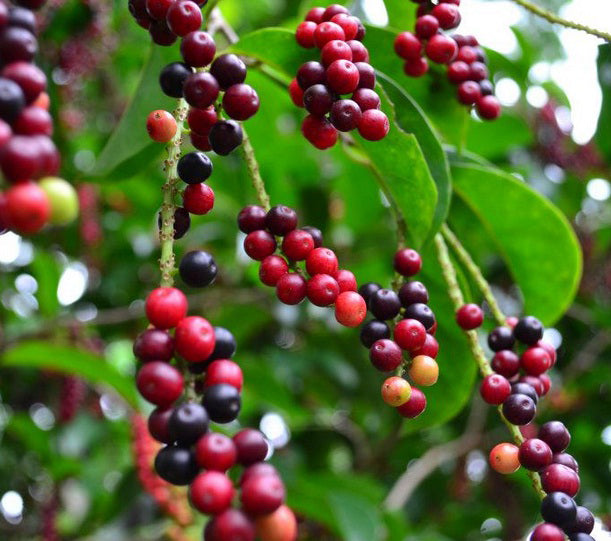Love it? Add to your wishlist
Your favorites, all in one place. Shop quickly and easily with the wishlist feature!
[message]
[title]
[message]




Veliyath Gardens
Couldn't load pickup availability
A Vibrant Berry Tree of Healing, Flavour, and Cultural Heritage
The Bignay Fruit Plant, botanically known as Antidesma bunius, is a vibrant, tropical berry-bearing tree revered for its medicinal properties, impressive nutritional content, and culinary versatility. Native to Southeast Asia and known by many names across different regions, Bignay has gradually earned a respected place in both traditional medicine and modern health practices. Its grape-like fruit clusters and vivid color transitions—from green to red to deep violet—offer not just visual charm but also a wealth of benefits packed into each small berry.
At Veliyath Gardens, we proudly cultivate this exceptional fruit plant, inviting you to bring home not just a tree, but a source of health, tradition, and natural sweetness.
Botanical Name: Antidesma bunius
Common Names: Bignay, Chinese Laurel, Currantwood, Buni
Names in Other Regions:
Philippines: Bignay
India: Kala-mania or Buni
Indonesia: Buni
Thailand: Mao Luang
From rural villages in the Philippines to herbal corners of India, the Bignay plant is known for its multipurpose uses and regional flavor significance.
A tall, evergreen tropical plant, reaching up to 8 to 15 meters in height with proper care.
Bears clusters of small, round berries resembling miniature grapes, each cluster holding 20 to 30 fruits.
The skin is thin but firm, transitioning from yellow-green when unripe to deep red and eventually bluish-purple when fully ripe.
Each berry contains a flat, hard seed encased in juicy pulp.
The plant’s leaves are smooth, oval, and glossy, contributing to its ornamental value.
This plant thrives in warm, humid regions and can be a charming focal point in any tropical or sub-tropical garden.
The flavor evolves with ripeness:
Unripe berries are tart and slightly sour.
Ripe berries become sweet, mildly tangy, and refreshing.
Popular in rural and gourmet kitchens alike, the fruit is:
Enjoyed raw for its unique burst of taste.
Transformed into jams, jellies, fermented wine, and sweet-sour sauces.
Used in traditional syrups and drinks, especially in Southeast Asia.
Its palate-pleasing, juicy nature makes it a favorite for both casual nibbling and serious culinary creations.
This small fruit hides a nutritional powerhouse beneath its vibrant skin:
Rich in vitamin C and vitamin A: Enhances immunity and supports eye and skin health.
Calcium and phosphorus: Strengthens bones and teeth.
Iron and thiamine: Improves blood health and metabolic function.
High in antioxidants, especially anthocyanins, responsible for its dark purple hue.
Contains riboflavin and niacin, supporting energy production and healthy nerves.
Antioxidant activity is notably high, making the fruit beneficial for detoxifying the body and combating oxidative stress.
Bignay is often considered a fruit that supports longevity, cellular repair, and general vitality.
For centuries, the Bignay plant has held a prominent place in folk healing and natural remedies:
In India, the leaves were traditionally used to counteract snake bites and insect stings.
In Philippine folk medicine, Bignay fruit is used as a natural cleanser and blood purifier.
Some indigenous communities apply boiled bark or leaf extract to treat skin conditions.
The fruit juice, rich in phenolic compounds, is considered a mild diuretic and digestive stimulant.
Its role in heritage medicine systems is testament to its potent natural chemistry.
Time to Fruit: Typically starts yielding fruit in 6 years.
Soil Preference: Well-drained, loamy or sandy soil with moderate organic matter.
Watering Needs: Regular but not excessive; drought-tolerant once established.
Sunlight: Thrives in full sun to partial shade.
Maintenance Level: Moderate—requires basic pruning and seasonal care.
With patience and care, the Bignay plant rewards growers with lush foliage and abundant harvests that improve year after year.
Fresh fruits are best consumed within a few days of picking.
Can be refrigerated for up to a week in airtight containers.
Fermentation into wine or vinegar is a common preservation method in Southeast Asia.
Used in sun-drying and boiling for homemade jams and syrups.
Traditional methods often involve cold-press juicing and storing in clay pots for natural fermentation.
The ability to transform the fruit into long-lasting preserves and drinks enhances its value both in the kitchen and as a pantry staple.
In the Philippines, Bignay is a backyard staple, often used to make festive red wine and fruit syrups.
In Indonesia and Malaysia, the fruit is sold in local markets and featured in village food festivals.
For rural communities in South India, it is valued as both a survival fruit and natural medicine.
Bignay wine and syrup-making is often a family tradition, passed through generations.
Its cultural significance adds an emotional dimension to growing this plant—it’s more than fruit; it’s legacy.
A natural antioxidant source at your doorstep.
Grows into a beautiful, shade-giving tree with glossy leaves and ornamental fruit clusters.
Offers culinary, medicinal, and traditional benefits in a single plant.
Suitable for tropical and sub-tropical gardens, both in ground and in large containers.
Encourages butterflies and birds, contributing to a living garden ecosystem.
The Bignay Fruit Plant (Antidesma bunius) is more than a fruit tree—it is a bridge between tradition and wellness, taste and nutrition. At Veliyath Gardens, we take pride in nurturing plants that celebrate biodiversity and heritage.
Add the Bignay tree to your garden, and let it gift you vibrant fruits, natural healing, and a quiet reminder of the wisdom of nature. Your journey to planting wellness begins here.
Time to Fruit: Typically starts yielding fruit in 6 years.
Soil Preference: Well-drained, loamy or sandy soil with moderate organic matter.
Watering Needs: Regular but not excessive; drought-tolerant once established.
Rich in vitamin C and vitamin A: Enhances immunity and supports eye and skin health.
Calcium and phosphorus: Strengthens bones and teeth.
Iron and thiamine: Improves blood health and metabolic function.
High in antioxidants, especially anthocyanins, responsible for its dark purple hue.
A natural antioxidant source at your doorstep.
Grows into a beautiful, shade-giving tree with glossy leaves and ornamental fruit clusters.
Offers culinary, medicinal, and traditional benefits in a single plant.





